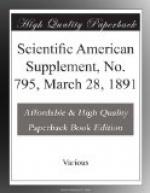When the variations in level due to different causes—rain, wind, and evaporation being the chief—are taken into consideration, the effect of 10,000 cubic feet a second abstracted would probably not be noticeable. That this would be so is the opinion, after careful investigation, of many eminent American engineers. On the other hand there is a similar unanimity of opinion as to the advantages that would be obtained in the condition of the Mississippi by adding to it a tributary of such importance as the proposed canal.—Engineering.
* * * * *
N.F. BURNHAM AND HIS LIFE WORK.
By W.H. BURNHAM.
The inventor and patentee of all water wheels known as the Burham turbine died from Bright’s disease of the kidneys at his home, York, Pa., Dec. 22, 1890, aged 68 years 9 months and 9 days. He was born in the city of New York, March 13, 1822, and was of English-Irish and French descent. His father was a millwright and with him worked at the trade in Orange county, N.Y., until he was 16 years old. He then commenced learning the watchmakers’ business, which he was obliged to relinquish, after three years, on account of his health. He then went to Laurel, Md., in 1844, and engaged with Patuxent & Co. as mercantile clerk and bookkeeper. In 1856 he commenced the manufacture of the French turbine water wheel. In 1879 he sold out his Laurel interests, went to New York and commenced manufacturing his own patents. On May 22, 1883, he founded the Drovers’ and Mechanics’ National Bank of York, and was elected its first president, which position he held at the time of his death. In 1881, with others, he built the York opera house, at a cost of $40,000. He was a Knight Templar, and past master of the I.O.O.F., and past sachem of Red Men.
[Illustration: N.F. BURNHAM.]
He was the oldest turbine wheel manufacturer living, having been actually engaged in the manufacture of turbines since 1856. He first made and sold the French Jonval turbine, which was then the best turbine made, but being complicated in construction, it soon wore out and leaked. From the experience he had from this wheel he invented and patented Feb. 22, 1859, his improved Jonval turbine, which was very simply constructed and yielded a greater percentage of power than the French Jonval turbines. Hundreds of these improved wheels, which were put in operation between the years 1859 and 1868, are still in use. (We show no cut of this wheel, but it had four chutes instead of six, as shown in March 24, 1863, patent.)




